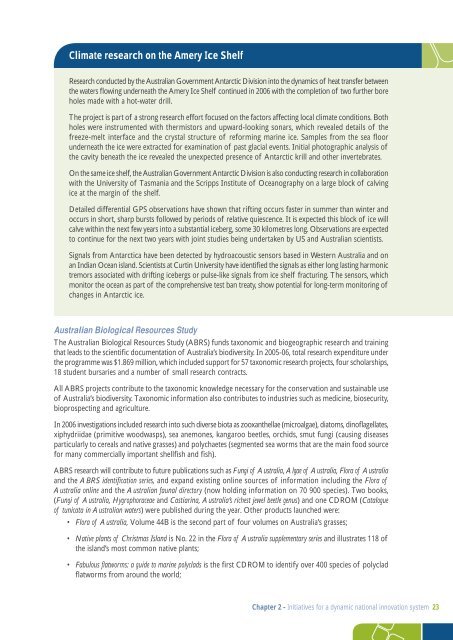The Australian Government's Innovation Report
The Australian Government's Innovation Report
The Australian Government's Innovation Report
Create successful ePaper yourself
Turn your PDF publications into a flip-book with our unique Google optimized e-Paper software.
Climate research on the Amery Ice Shelf<br />
Research conducted by the <strong>Australian</strong> Government Antarctic Division into the dynamics of heat transfer between<br />
the waters flowing underneath the Amery Ice Shelf continued in 2006 with the completion of two further bore<br />
holes made with a hot-water drill.<br />
<strong>The</strong> project is part of a strong research effort focused on the factors affecting local climate conditions. Both<br />
holes were instrumented with thermistors and upward-looking sonars, which revealed details of the<br />
freeze-melt interface and the crystal structure of reforming marine ice. Samples from the sea floor<br />
underneath the ice were extracted for examination of past glacial events. Initial photographic analysis of<br />
the cavity beneath the ice revealed the unexpected presence of Antarctic krill and other invertebrates.<br />
On the same ice shelf, the <strong>Australian</strong> Government Antarctic Division is also conducting research in collaboration<br />
with the University of Tasmania and the Scripps Institute of Oceanography on a large block of calving<br />
ice at the margin of the shelf.<br />
Detailed differential GPS observations have shown that rifting occurs faster in summer than winter and<br />
occurs in short, sharp bursts followed by periods of relative quiescence. It is expected this block of ice will<br />
calve within the next few years into a substantial iceberg, some 30 kilometres long. Observations are expected<br />
to continue for the next two years with joint studies being undertaken by US and <strong>Australian</strong> scientists.<br />
Signals from Antarctica have been detected by hydroacoustic sensors based in Western Australia and on<br />
an Indian Ocean island. Scientists at Curtin University have identified the signals as either long lasting harmonic<br />
tremors associated with drifting icebergs or pulse-like signals from ice shelf fracturing. <strong>The</strong> sensors, which<br />
monitor the ocean as part of the comprehensive test ban treaty, show potential for long-term monitoring of<br />
changes in Antarctic ice.<br />
<strong>Australian</strong> Biological Resources Study<br />
<strong>The</strong> <strong>Australian</strong> Biological Resources Study (ABRS) funds taxonomic and biogeographic research and training<br />
that leads to the scientific documentation of Australia’s biodiversity. In 2005-06, total research expenditure under<br />
the programme was $1.869 million, which included support for 57 taxonomic research projects, four scholarships,<br />
18 student bursaries and a number of small research contracts.<br />
All ABRS projects contribute to the taxonomic knowledge necessary for the conservation and sustainable use<br />
of Australia’s biodiversity. Taxonomic information also contributes to industries such as medicine, biosecurity,<br />
bioprospecting and agriculture.<br />
In 2006 investigations included research into such diverse biota as zooxanthellae (microalgae), diatoms, dinoflagellates,<br />
xiphydriidae (primitive woodwasps), sea anemones, kangaroo beetles, orchids, smut fungi (causing diseases<br />
particularly to cereals and native grasses) and polychaetes (segmented sea worms that are the main food source<br />
for many commercially important shellfish and fish).<br />
ABRS research will contribute to future publications such as Fungi of Australia, Algae of Australia, Flora of Australia<br />
and the ABRS identifi cation series, and expand existing online sources of information including the Flora of<br />
Australia online and the <strong>Australian</strong> faunal directory (now holding information on 70 900 species). Two books,<br />
(Fungi of Australia, Hygrophoraceae and Castiarina, Australia’s richest jewel beetle genus) and one CDROM (Catalogue<br />
of tunicata in <strong>Australian</strong> waters) were published during the year. Other products launched were:<br />
• Flora of Australia, Volume 44B is the second part of four volumes on Australia’s grasses;<br />
• Native plants of Christmas Island is No. 22 in the Flora of Australia supplementary series and illustrates 118 of<br />
the island’s most common native plants;<br />
• Fabulous fl atworms: a guide to marine polyclads is the first CDROM to identify over 400 species of polyclad<br />
flatworms from around the world;<br />
Chapter 2 - Initiatives for a dynamic national innovation system 23












![[Tam] Uygula[ya] - Bilim, Teknoloji ve Ä°novasyon Politikaları TartıÅma ...](https://img.yumpu.com/36820041/1/184x260/tam-uygulaya-bilim-teknoloji-ve-anovasyon-politikalara-tartaama-.jpg?quality=85)



